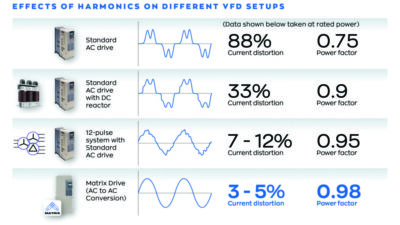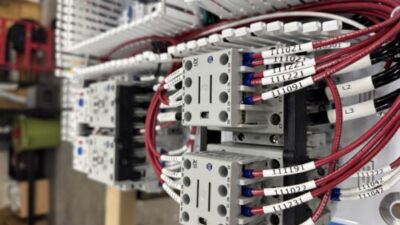Common dc bus drive systems are gaining in popularity. They are compact and require less cabinet space. Efficiency is enhanced because they share power on the dc bus. Ultimately, they are cost-effective solutions to common drive problems and offer a wide range of features applicable to many industries and power ranges.
Common dc bus drive systems are gaining in popularity. They are compact and require less cabinet space. Efficiency is enhanced because they share power on the dc bus. Ultimately, they are cost-effective solutions to common drive problems and offer a wide range of features applicable to many industries and power ranges.
The typical stand-alone ac drive consists of a single contained unit that includes a rectifier, dc link, and inverter. With a common dc bus system a common rectifier supplies power to the dc bus for the inverters (dc-ac units), instead of individual rectifiers used in stand-alone ac drives. For more elaborate applications regenerative rectifiers and active front ends can also be used to power the dc bus. Regardless of the dc power source, common dc bus drive systems provide many benefits when compared to a system of stand-alone units.
In addition to design flexibility, common dc bus drive systems are very efficient. Power sharing on the dc bus is possible with applications that have different inverters that simultaneously motor and generate power. The drive system is more efficient because it uses less power from the rectifier when the generating units are sending power to the common dc bus to be used by the motoring units.
Further cost savings are possible because only one larger system component is used instead of many smaller units, i.e., reactors, braking units, contactors, etc. This reduces the number of parts used on the drive system. It also results in fewer failures and spare part items.
Fewer system components equate to less panel space. More importantly, further cost and panel space savings are possible because the power requirements of the rectifier and system components are often lower than the sum of inverters. This is due to power sharing and a coincidence factor figured into the design since not all inverters will heavily load the rectifier at the same time.
In addition to lower power and hardware costs, common dc bus systems save assembly and wiring time. Eliminating wiring to all the individual system components and easy connection to the dc bus also result in a cleaner, smaller and simpler layout.
Drive manufacturers are focusing on simplifying the connection to the dc bus. Today, look for designs with built-in bus bar connections that eliminate the need for wiring the dc bus. Only a bus bar or internal connection jumpers are required. Built in dc link fusing is also another benefit that eliminates wiring and external devices.
As an example, Siemens’ Masterdrives Compact Plus AC drive series is designed with the rectifier section on the stand-alone ac drives sized twice the rating of its inverter section to be able to power additional inverter units over the dc bus. This design eliminates the cost and space of a separate rectifier unit on small common dc bus systems and still incorporates all the benefits of a common dc bus system.
www.sea.siemens.com .
Author Information
Craig Nelson is applied ac drives product manager for Siemens; Andrew Miller is an application engineer for Siemens.



